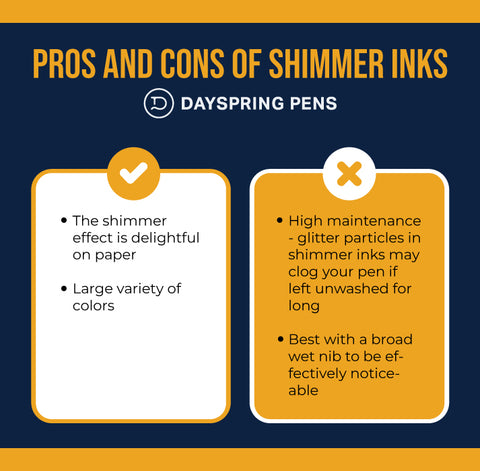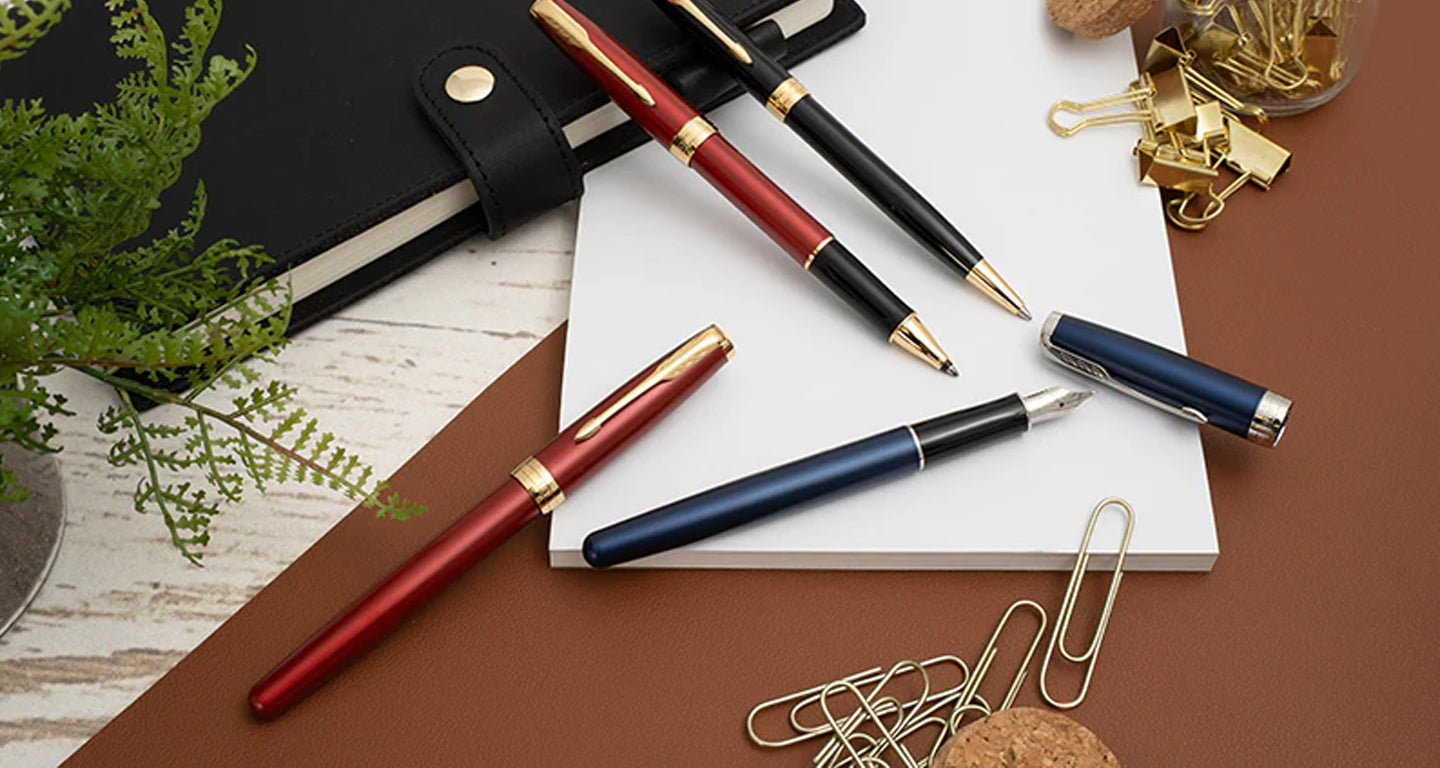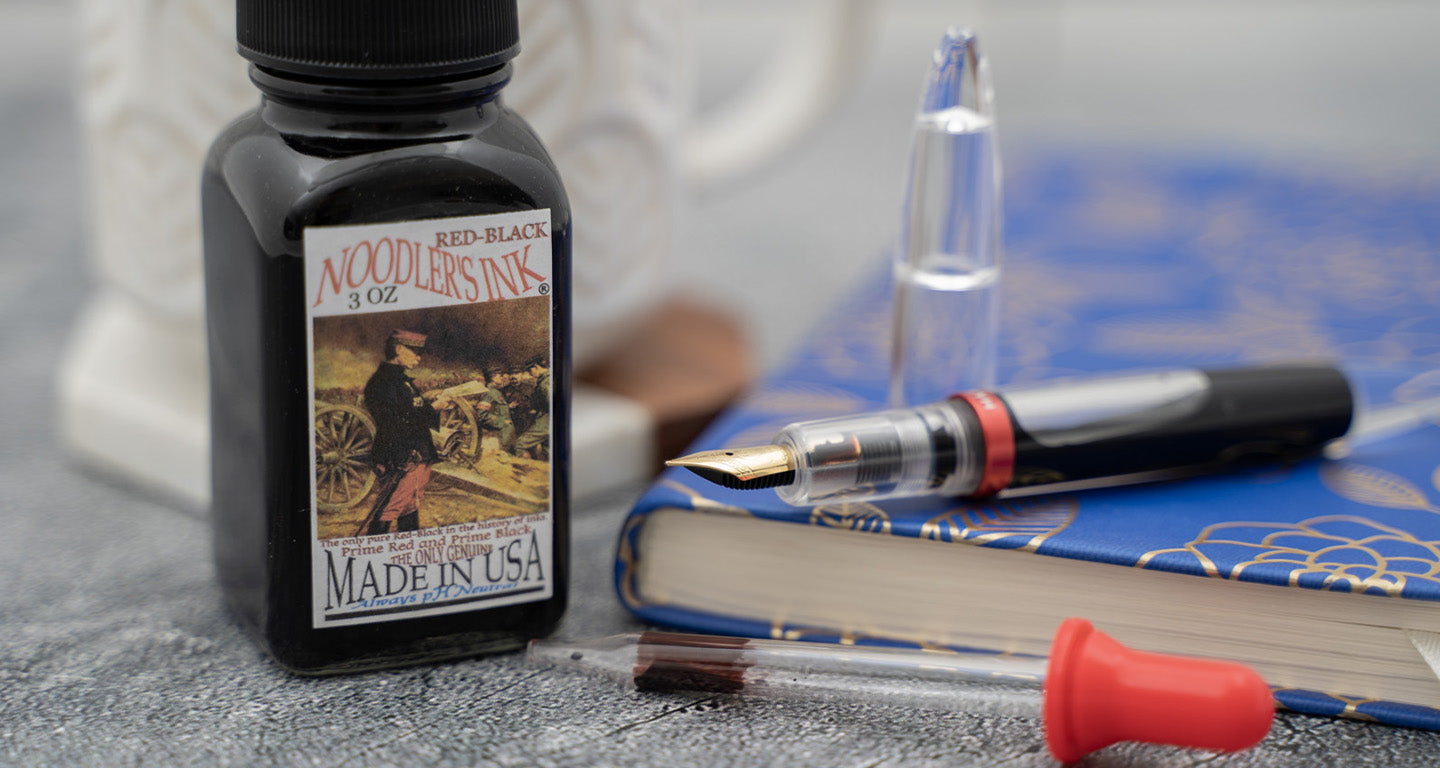
The Ultimate Guide to the Different Types of Fountain Pen Ink
There are different types of fountain pen ink, each with unique characteristics. There are some that seem to sheen, some with different shades on paper, and some that last for what seems like hundreds of years. Others have a fantastic shimmer that will leave both you and your readers dazzled.
Ink has many uses. While some are great for calligraphy, others are excellent for administrative work that requires a high degree of permanence.
Indeed, there are many different colors of ink. Are you a purist who wants the all-time classic and versatile black ink? Are you a creative who wants a more adventurous option?
However, whatever your taste and intended use, there’s an inkpot out there for you. And if it doesn’t exist yet, you can mix a batch up for yourself.
Saying ink is just ink is like saying that the One Ring is just an accessory for a Hobbit’s finger.
This guide aims to teach you all you need to know about the different fountain pen ink types.
By the end, you'll be more informed when shopping for your next refill.
Here's what you'll learn in this ultimate guide to the different types of fountain pen inks:
- The main types of fountain pen inks that are available in the market.
- The various factors that you should consider when deciding on the kind of ink to buy.
- Where you should purchase converters for your pens.
What Are the Different Types of Fountain Pen Ink?
Dye Inks
Dye inks consist of chemical components dissolved in water. Dye-based inks are the most widely available of all the fountain pen inks.
In comparison to other inks, dye-based inks are quite affordable.
It's also easy to take care of your fountain pen when using water-soluble dye-based inks:
- Firstly, it's highly unlikely for dye-based pen inks to clog up your fountain pen elements. You see, colorants dissolve in water completely. This means there's no sediment left behind to clog up your ink fountain pen.
- Secondly, in the unlikely case that it does, all you need to do is flush your pen with water and voila! You've solved your clogging problem.
 Image Source: Goldspot Pens on YouTube
Image Source: Goldspot Pens on YouTube
Due to the soluble nature of dye inks, however, they are not waterproof. It's easy for your notes to run or smudge when they come in contact with water.
Here are the pros and cons of dye-based pen inks:
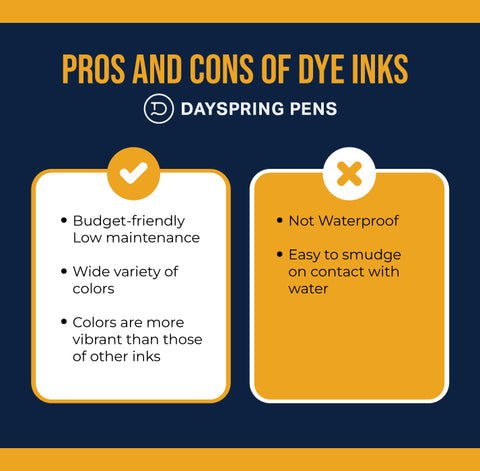
Pigment Inks
Pigment-based types of fountain pen ink consist of fine solid particles of colorants mixed with water. However, these colorants are not water-soluble, and they remain suspended in the water.
This aspect of pigment-based inks is why they demand regular cleaning of your pen. However, if left unattended, these solid particles can clog up your fountain pen feed. This obstructs the ink’s flow to your nib.
Because of the physical aspect of pigment inks, they offer more permanence. However, the solid particles sit on the paper and bond to the fibers over time. There's no fading on exposure to sunlight, as is the case with chemical dye inks.
Here are the pros and cons of using pigment inks with your pen:
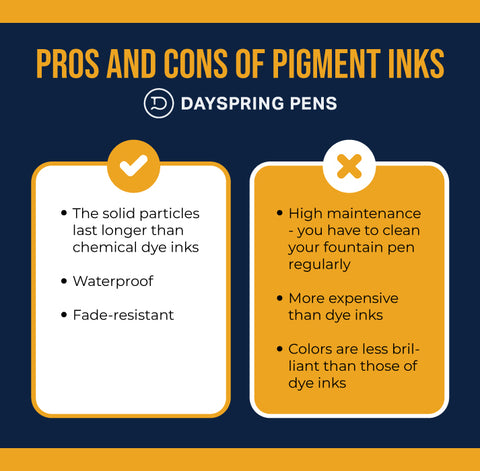
Iron-Gall Inks
Iron-gall inks are made by reacting tannic acid and iron (II) ions.
The tannic acids used in the inks are extracted from the galls of oak trees and other trees. Thus the 'gall' in iron gall ink.
When applied on paper, the ink darkens to a deep purple-black color due to the oxidation of iron. It dries significantly darker in the wetter spots. Consequently, this quality gives the strokes on the paper an attractive shading effect.
Another revered quality of iron-gall inks is their permanence. When oxidized, iron gall inks become water-insoluble. This insolubility makes them permanent. Permanence is favored for archival projects such as issuing birth certificates. Indeed, many a marriage certificate has been signed using iron-gall inks. If you have one lying around, go have a look at it.
Old manuscripts written using iron gall inks have maintained their legibility for centuries. The Miniature Silhouettes at the National Archives are one example.
|
Cool fact #1: Leonardo da Vinci wrote many of his manuscripts using iron-gall ink. Cool fact #2: The Codex Sinaiticus, the oldest Bible known to man, was written using iron-gall. |
A word of caution: Iron-gall inks are acidic. Acid is corrosive.
If you decide to use iron-gall inks in your fountain pen, make sure it's the fountain pen you use regularly. Your daily driver. This is because iron gall inks will corrode your pen’s metallic innards if left too long inside there.
Make sure to clean your pen using clean water regularly.
Here are the pros and cons of using iron gall inks with your fountain pen:
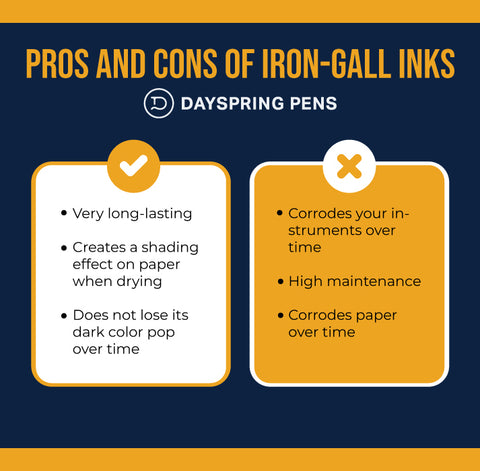
Bulletproof Ink
Bulletproof ink is a dye-based formulation. It combines the benefits of both pigment-based and dye-based inks.
Bulletproof inks bind with the paper's cellulose fibers to achieve waterproofness. This gives them a high degree of permanence.
Because Bulletproof pen ink is dye-based, it requires low maintenance. You don't have to regularly clean out your pen to wash away the solid particles left inside.
Other permanent inks are either pigment-based or iron-gall based inks. Both of these have their downsides. For example, iron-gall is corrosive. Pigment inks require you to clean your pen regularly to prevent clogging.
Here are the pros and cons of using bulletproof inks in your pen:
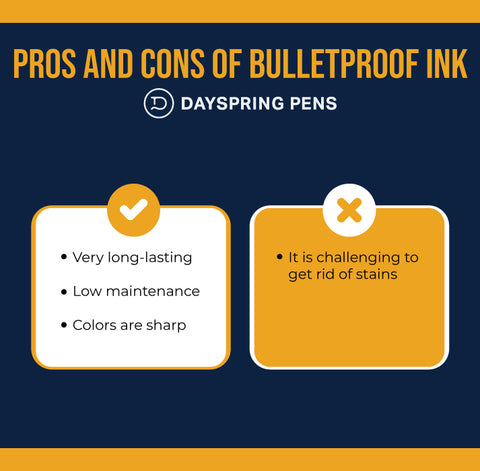
Shimmer Inks
Most people have shimmer, sheen, and shading mixed up.
Sheen is where ink exhibits two different colors when it dries on the surface of your paper.
For example, a purple ink might have a golden sheen. A red one might have a purple sheen.
How does sheening work?
Sheening happens when the ink has not fully absorbed into the paper’s cellulose paper fibers. It sits on the surface of the paper and develops a sheen as it dries.
To get the best sheening results, use a wet nib on smooth paper with low absorption.
What is Shading?
Shading is when ink seems to fade from one end of each of your strokes to the other. The saturation of ink is higher where your strokes begin and end. It will appear faded in the midsection of your strokes.
 Image by Roman Yakimovich on Pinterest
Image by Roman Yakimovich on Pinterest
Shading gives your writing a good deal of character.
Applications of Shading and Sheening
As is the case with sheening, use a low-absorption paper. This will allow your ink to sit on top of the paper's surface for some time. It'll then pool in different sections of your characters’ strokes. This will bring about the desired shading result.
Some people love the shading effect. Others find the abrupt transitions in ink intensity very distracting.
Shimmer inks are fountain pen inks that have been infused with glitter. Your writing glitters on paper when you use shimmering ink.
In formal professional settings, shimmer inks might come off as inappropriate.
Use shimmering inks when writing informal letters or jotting down the day's events in your journal.
 Image by Nick Stewart Ink Art on twitter.com
Image by Nick Stewart Ink Art on twitter.com
You need to shake your ink bottle well before refilling your pen. This is because the glitter will settle at the bottom of the bottle after a while of stillness.
Use a broad wet nib when you use shimmer pen inks to derive a better shimmering effect. A fine dry nib will spread out the glitter too much, and the shimmer effect won't be as noticeable on the paper.
Here are the pros and cons of using shimmering inks with your pen:
Experiment with shade, sheen, and shimmer to find what works best for you.
Scented Inks
These are fountain pen inks that utilize fragrances to add character to your writing.
Spice up your letters and journals by using fountain pens with the ink of different scents. Your readers will appreciate the effort.
Factors to Consider When Picking Out Types of Fountain Pen Ink
Drying Time
Due to the high viscosity of fountain pen inks, fast-drying isn't their strongest suit.
Depending on the type of pen and paper you're using, you might wait for more than a minute for ink to dry on the paper.
If you are left-handed or take lots of notes with ink fountain pens, this may sound impractical.
Look for pen inks that dry fast after being applied on paper.
Is Ink Waterproof?
That moment when you spill tea or some drinking water on your notes. Can you relate?
However, you're going to use fountain pen ink regularly, you should take note of its waterproofness.
Most inks have a degree of waterproofness. If you happen to get your notes wet when, or after, writing, they will still be legible, although smeared.
Some inks are entirely waterproof when dry. These have a high degree of permanence.
Color Saturation of the Ink
How much colorant is in your bottle of ink? Is the color very concentrated? Is it very diluted?
If your ink is colorant saturated, your writing will be dark and vibrant. Your notes will pop out more.
If it is less saturated, your writing will have less vibrance. The color will look a bit faded because the water to colorant ratio is off-kilter.
The Wetness of Your Ink
The wetness of your ink refers to its level of viscosity.
While wet inks flow quickly through to your pen nib, dry inks flow slowly through your pen.
If your handwriting is small and your characters tight-knit, you should go for a dry ink.
Wet ink will make your characters run into each other because they're close to one another. This will make for messy work.
However, if you have big handwriting with bold letters, a wet ink will suit you best. The heavy flow will accentuate your large characters and strokes.
| Related Reading: How to Choose Your Perfect Pen for Your Handwriting Style |
Bottled Ink or Cartridges?
Some fountain pen users swear by ink cartridges, and others by bottled ink.
To help you decide which one to use with your pens, here are the pros and cons of each:

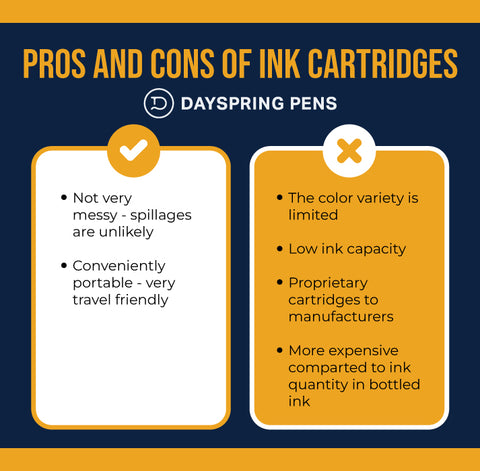
As mentioned above, some fountain pen companies have proprietary cartridges. This means you can only use their in-house ink cartridges. Cartridges by other companies won't work on your pen.

Other companies, however, use Standard International cartridges. These enable you to swap inks between pens from different manufacturers.
Some brands also allow you to swap between cartridges from different companies.
Here's a guide showing you the type of cartridges used by the major brands:
| • Waterman | Standard International |
| • Sailor | Sailor |
| • Pelikan | Standard International |
| • Monteverde | Standard International |
| • Parker | Parker or Aurora |
| • Aurora | Aurora, Lamy, or Parker |
| • Platinum | Platinum |
| • Montblanc | Standard International |
| • Lamy | Lamy |
| • Kaweco | Standard International |
| • Cross | Cross |
| • Pilot | Pilot |
Does your pen's manufacturer limit you to only using their proprietary ink cartridges?
| Shop Now: Ink pen refills from Dayspring Pens |
Get a Good Ink Converter
Fountain pen ink converters give you the freedom to use bottled ink. This opens you up to a world of hundreds of ink colors. However, cartridges don't give you this wide a variety of colors.
At Dayspring Pens, we specialize in personalized gifts suited for any occasion, and the ink refills that go with them.
Buy ink converters that are the perfect pairing to your fountain pen. This grants you instant access to all the bottled ink colors in the world.
Contact us for any assistance you may need in making your ink selection.
We're happy to help.
Featured image: flickr.com
|
|
Daniel Whitehouse is the President and CEO of Dayspring Pens. He uses his expertise with premium writing utensils to create exceptional, intentional products and craft easy-to-understand articles that help both new and experienced users learn more about their writing tools. He lives in Virginia where he and his wife are raising their four children. To learn more about him and his insights about custom engraved gift pens, follow Daniel on LinkedIn. |
Share
15 comments
Daniel,
Excellent information.
Thank you.
Daniel
Lots of kudos to the Narendra Modi government which prevents all the senior bureaucrats from using inks having a colour other than black or blue in any official documents.
@HENRY G that is a great suggestions! I will add recommendations to the list!
Very useful information for beginners like me, BUT, how could we know which type is the ink we find on the market. Let’s say, the Montblanc bottles (the old 50ml or the new version with 60ml). It would be even more helpful if some examples of each type are added to the article. …and also really appreciated!! :)
@TIMOTHY MCI I would recommend checking out Goulet Pens blog for brands that tend toward wetter or drier inks. They have a top 10 for both with a great breakdown of what makes each brand wetter or drier. They do not go into Birmingham Inks, but from my understanding of reviews I have read (mind you I haven’t tried any myself) they often get compared to Noodlers or Diamine which both are wetter inks.

